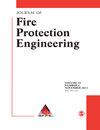Physical scaling of water mist protection for ignitable liquid cut-off rooms:
引用次数: 4
Abstract
Based on the Froude-modeling scaling approach, water mist protection for a 7.47 × 7.47 × 7.47-m cut-off room where ignitable liquids are used was projected from the previously determined extinguishing requirement for heptane pool fires in a ½-scale enclosure and then verified with full-scale testing. The full-scale building occupancy was required to accommodate cut-off room door openings ranging from 1.86 × 3.73 m high up to 3.73 × 3.73 m. The fire challenge was a heptane spill fire cascading from the top of a 1.83-m dia. by 2.74-m high steel tank at a spill rate of 37.9 L/min. Two off-the-shelf nozzles were selected as candidates for the full-scale building to approximate the scaled-up water mist spray requirement. At a discharge pressure of 90 bar, one nozzle discharged 28 L/min, with a spray angle of 100° and a volume-median droplet dia. of 115 µm; the other discharged 24.4 L/min, with a 180° spray angle and median dia. of 96 µm. Nine nozzles were arranged at the ceiling level in a 3 × 3 matrix with a spacing of 1.86 × 1.86 m. Before the two candidate protection schemes were challenged with the spill fire, scaled-up heptane pool fires were used to ensure that the fire extinguishing propensity was consistent with that observed in the ½-scale enclosure. The pool fire tests showed that the nozzle with the smaller spray angle provided better fire extinguishing performance, which was later confirmed in the spill fire tests. The protection scheme with the smaller spray angle could extinguish the spill fire for door openings up to 3.05 × 3.05 m. For larger openings, two additional downward water mist sprays were required in the door opening to expedite fire extinguishment by reducing ventilation through the door opening. Water mist protection could provide adequate cooling to fuel tanks as long as such protection could extinguish the fire. Overall, the investigation demonstrated that physical scaling is a useful tool to provide an engineering estimate of water mist protection requirements. Language: en可燃液体切断室水雾防护的物理结垢
基于froude模型缩放方法,根据先前确定的在1 / 2比例的封闭环境中对正烷池火灾的灭火要求,对使用可燃性液体的7.47 × 7.47 × 7.47 m封闭房间的水雾保护进行了预测,然后通过全尺寸测试进行了验证。全尺寸的建筑占用需要容纳从1.86 × 3.73米高到3.73 × 3.73米高的截止房间门。火灾挑战是从1.83米直径的顶部倾泻而下的庚烷溢出火灾。以37.9升/分钟的溢出速率,通过2.74米高的钢罐。两个现成的喷嘴被选为全尺寸建筑的候选者,以接近按比例放大的水雾喷雾要求。在排出压力为90 bar时,一个喷嘴排出量为28l /min,喷射角为100°,液滴直径为体积中值。115µm;另一种为24.4 L/min,喷角180°,中值直径。96µm。9个喷嘴以3 × 3的矩阵布置在顶棚水平,间距为1.86 × 1.86 m。在两种候选保护方案受到泄漏火灾的挑战之前,使用了按比例扩大的庚烷池火灾,以确保灭火倾向与在1 / 2比例外壳中观察到的灭火倾向一致。池火试验结果表明,喷雾角越小的喷头灭火性能越好,随后的溢火试验也证实了这一点。较小喷角防护方案可扑灭3.05 × 3.05 m范围内的门口溢火。对于较大的开口,需要在门开口处增加两个向下的水雾喷雾,通过减少通过门开口的通风来加速灭火。水雾保护可以为燃料箱提供足够的冷却,只要这种保护可以扑灭火灾。总的来说,调查表明,物理标度是提供水雾保护要求的工程估计的有用工具。语言:在
本文章由计算机程序翻译,如有差异,请以英文原文为准。
求助全文
约1分钟内获得全文
求助全文

 求助内容:
求助内容: 应助结果提醒方式:
应助结果提醒方式:


